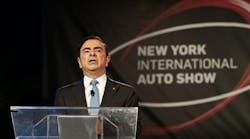Nissan's Ghosn Tries Again to Revive Sputtering Truck Sales
Carlos Ghosn opened the New York auto show saying the industry is going to change more -- with connectivity, autonomy and electrification -- in the next five years than it has in the past 20. One thing that’s likely to stay the same: Big pickups are hugely popular and profitable in the U.S. -- and dominated by domestic brands.
Last year, when Ghosn announced a completely new design for his Titan pickup, he predicted that by the end of 2017 he’d capture 5% of U.S. truck sales. That’s about 100,000 trucks a year. At the New York show on March 24, the company is scheduled to provide additional details as gasoline-powered versions of the Titan go on sale this year. But the model has a long way to go: So far in 2016, its share of the full-size pickup market is only 0.6%.
Ghosn’s pickup saga is full of missed opportunities and bad luck. It’s also a story of the fierce determination of Detroit automakers to defend one of their last bastions of power and profit.
“Nissan is pretty much the forgotten pickup brand at this point,’’ said Dave Sullivan, an analyst with AutoPacific. “They let the product get stale and it’s going to be a long climb back.’’
Gaining ground in pickups is crucial for Nissan to reach 10% overall U.S. market share, which the company has previously said could be achieved by the fiscal year ending March 2017. Instead, this milestone may two to three years away, Ghosn said March 23.
Nissan (IW 1000/33) accounted for 8.5% of U.S. industry sales in 2015.
During the first two months of 2016, Nissan sold 1,997 Titans in the U.S. That compares with 112,237 for Ford Motor Co.’s F-Series, 110,582 for General Motors Co.’s Chevrolet Silverado and GMC Sierra, and 68,493 for Fiat Chrysler Automobiles NV’s Ram.
Toyota sold 15,533 of its Tundra pickups. Honda stopped selling its Ridgeline pickup -- built on a car platform -- in 2014 and will reintroduce it later this year.
Truck Awards
On the sidelines of the New York show, Ghosn said he’s confident 2016 will finally be the year in which he breaks into the mainstream of truck sales. He said the acceleration of Titan production is proceeding smoothly and he’s convinced it will do well in part because of awards the truck has received from journalists and others. These include the “Truck of Texas” award from the Texas Auto Writers Association last year.
“We have a good product, a very competitive product. We have a sales development which is going well so far. That’s why we are optimistic,’’ Ghosn said. “To fulfill our potential, we need to have a bigger presence in the large pickup truck.’’
Nissan also unveiled a refreshed GT-R supercar, with available Nappa leather and a restyled exterior, and “mobility concepts” that may point the way to the future of how people get around in big cities. But for the foreseeable future, the top-selling models in the U.S. will continue to be full-size pickups.
Difficult Entry
When Ghosn introduced Titan in 2003, the company was plagued by quality problems at a new factory it had just built in Canton, Mississippi, said AutoPacific’s Sullivan. The bigger issue, for Nissan and the other Japanese automakers, was that they were learning to build vehicles that are sold almost exclusively in North America. This meant that, unlike with a Nissan Altima sedan, they couldn’t spread their costs around a global manufacturing and sales base.
Bowing to this reality –- and his concurrent pledge to invest $6 billion in the Nissan Leaf electric car -- Ghosn agreed in 2008 to pay Chrysler to build pickups on which he’d place the Titan name. Then Chrysler went bankrupt and got acquired by Fiat -- and the arrangement was scrapped.
Despite some minor design updates, the Titan remained largely unchanged after its debut in 2003, while GM, Ford and Chrysler were announcing major changes every 18 to 24 months, Sullivan said. And well they might, given the importance of pickups to their future.
F-Series Profit
“The F-Series generates close to 100 percent of Ford’s global profit,’’ said Sean McAlinden, chief economist at the Center for Automotive Research in Ann Arbor. “They’re not making a dime on passenger cars.’’
Truck buyers are loyal, too, said Alan Baum, an independent auto analyst in West Bloomfield, Michigan.
“The problem with the new Titan is that it’s a Nissan,’’ Baum said. “This is a market where loyalty and experience matter, and they simply don’t have it.’’
Ghosn started building the second generation of his Titan pickup in November. He started with the Titan XD, which is powered by a 5-liter, 310-horsepower diesel engine built by Cummins Inc. The XD starts at $40,290. That’s about $8,000 more than its gasoline-powered cousin, and demand suffered as gasoline prices plunged, Sullivan said.
Titan Variants
Ghosn will keep adding variations that by the end of 2016 will total three cab configurations, two frame sizes, three engines and five trim levels. Given this complexity, and that fact that several of these options are brand new for Nissan, Sullivan said Ghosn is smart to move slowly as he adds multiple variants.
Sullivan predicts that by 2020, Ghosn or his successor will be selling 67,600 Titans a year. That’s only two-thirds of the goal Ghosn set for 2017, and it may not be enough to generate investment dollars needed to keep the truck competitive.
“What’s really incredible,’’ Sullivan said, “is that they’re trying this again.’’




